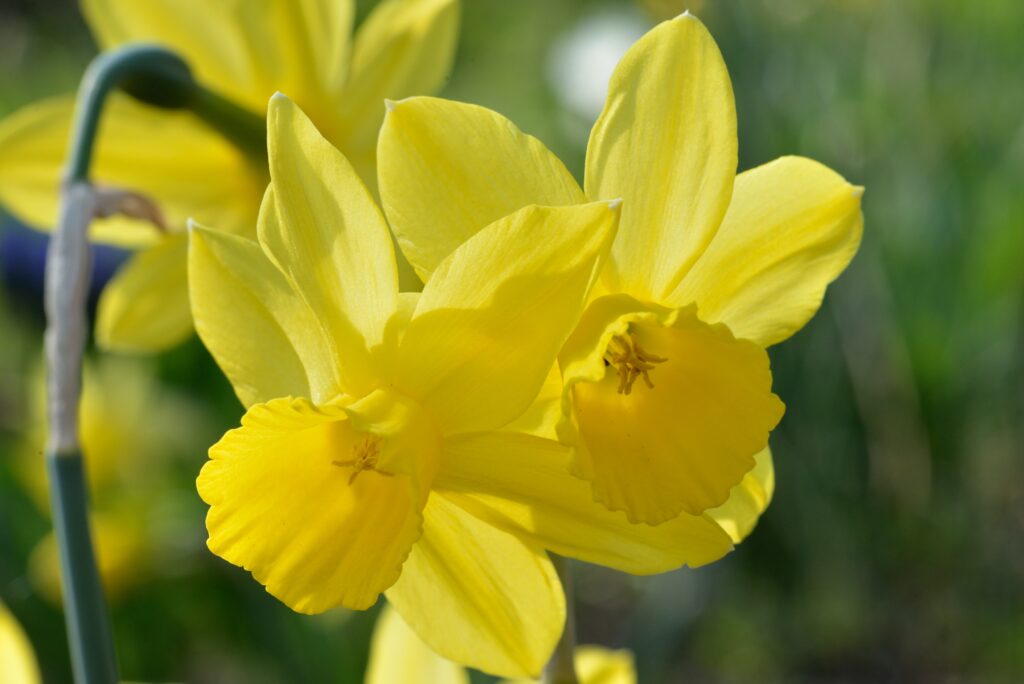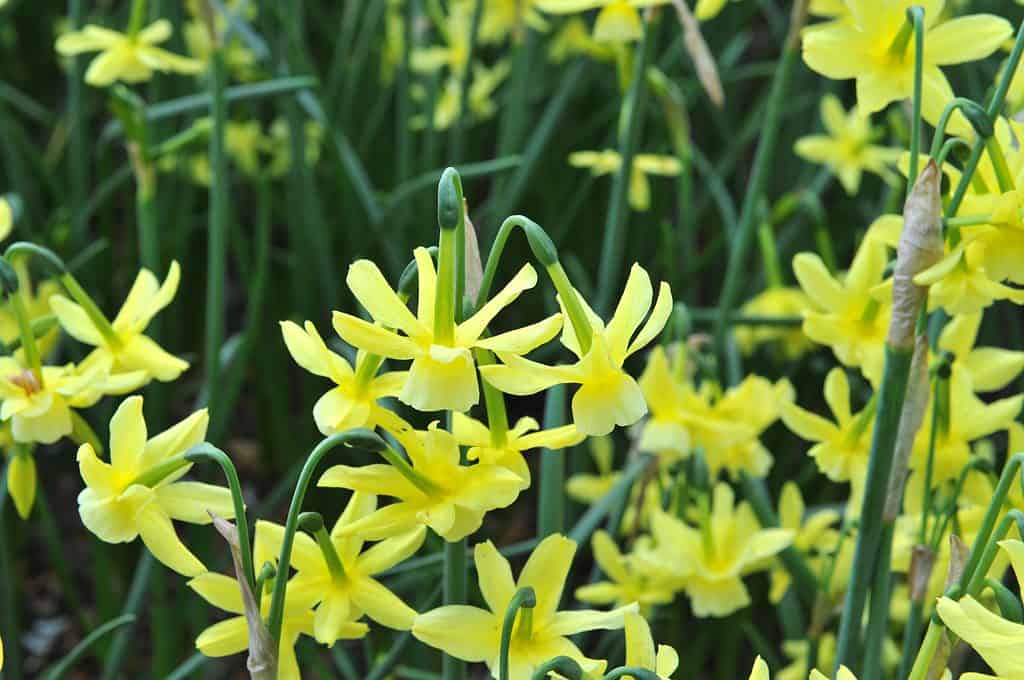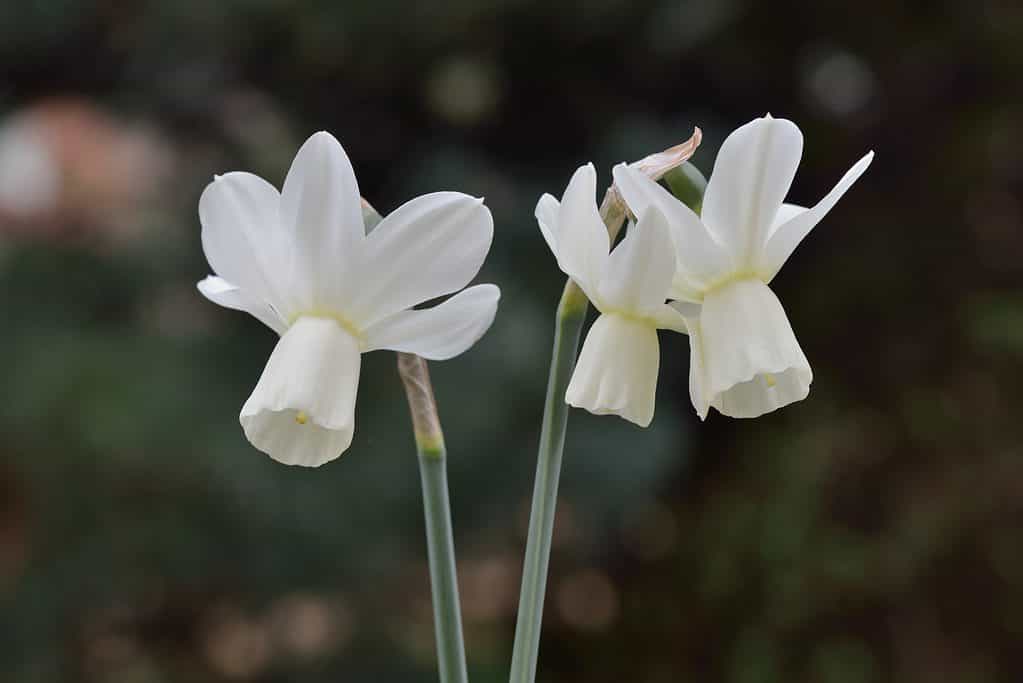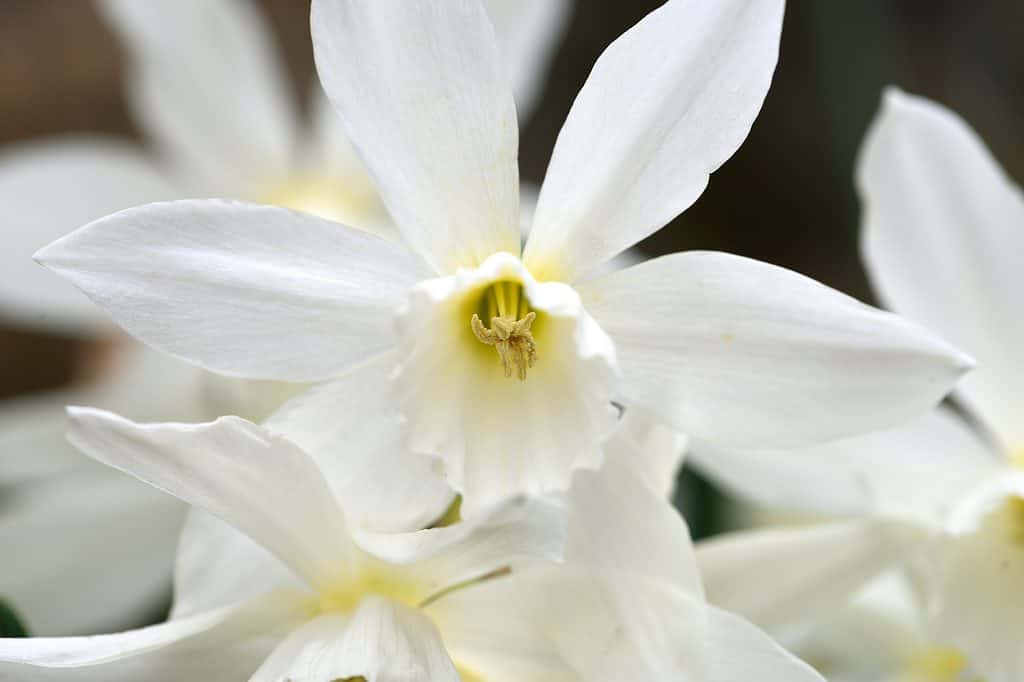With multiple pendant flowers nodding gracefully in the garden, each triandrus daffodil plant is a marvel of showy blooms. Triandrus daffodils are also marvelous for their soft colors and reflexed petals. So it’s very exciting to share five types of triandrus daffodils for spring garden interest!
But if you’re a newbie daffodil gardener, start with our quick guide to triandrus daffodil traits and a handy list of all 13 daffodil divisions.

Triandrus daffodils produce multiple nodding flowers per stem.
©Walter Erhardt/Shutterstock.com
What Are Triandrus Daffodils?
Multiple swaying pendant blooms per stem and flowers with reflexed petals are the two main ways triandrus daffodils are classified. They belong to division #5 of the 13 divisions that identify the hundreds of daffodil varieties available today.
Along with those main traits, triandrus daffodils often have these additional characteristics:
- monochrome or muted colors of yellow or white (sometimes both) or pink
- miniature plants with small blooms
- beautifully scented
- make great hybrid plants when crossed with other types of daffodils, like jonquillas and large-cupped varieties
But the triandrus daffodil division is just one of many! Keep reading for a complete list and quick guide to the 13 daffodil divisions and their unique traits.

Each type of daffodil has its own division. For example, the ‘Tete-a-Tete’ cultivar is a cyclamineus daffodil.
©Helen J Davies/Shutterstock.com
What Are Daffodil Divisions?
Daffodils are classified via a system of 13 divisions officially designated by the Royal Horticultural Society. Divisions for each daffodil include growth habits, like the shape and position of daffodil petals. This system makes it much easier to identify the many different daffodil types and cultivars grown today and throughout history.
Also, it’s important to know the basic terms below when learning about daffodil divisions.
- Anthers = male organs of the flower that produce pollen
- Corona = the center cup or trumpet of the flower
- Pedicel = the stem of the flower that is also called the flower neck
- Perianth segments = the flower petals
- Whorl = a ray-like positioning of flower parts from one point on the plant

Double daffodils like the ‘My Story’ cultivar belong to the daffodil division #4.
©Sergey V Kalyakin/Shutterstock.com
All 13 Daffodil Divisions Defined
Here’s the full list of the 13 daffodil divisions and the traits of each type of plant:
#1 = Trumpet Daffodils
- Flowers: Trumpet daffodils have one flower per plant stem.
- Cup (Corona): Their center cups have trumpet shapes with a length that is either equal to or longer than this daffodil’s petals.
#2 = Large-Cupped Daffodils
- Flowers: Large-cupped daffodils produce one big flower per plant stem.
- Cup (Corona): This flower’s cup grows more than a third of the length of its petals but not the entire length.
#3 = Small-Cupped Daffodils
- Flowers: Small-cupped daffodils usually grow one flower per plant stem.
- Cup (Corona): The small-cupped daffodil grows cups that are a third or less than the length of its petals.
#4 = Double Daffodils
- Flowers: The double daffodil produces one or more flowers per plant stem.
- Cups/Petals: This flower has at least double the petals of other daffodils or double the number of cups or both.
#5 = Triandrus Daffodils
- Flowers: The triandrus daffodil (featured in this article) features two or more nodding (pendant) blooms per plant stem.
- Petals (Perianth Segments): The petals of this plant’s flowers are usually reflexed (inverted).
#6 = Cyclamineus Daffodils
- Flowers: Cyclamineus daffodils feature one flower per plant stem.
- Petals (Perianth Segments): This flower typically has strongly reflexed petals.
- Flower Position: Cyclamineus daffodil blooms have shortened necks (pedicels) and tip downward from an acute angle.
#7 = Jonquilla Daffodils
- Flowers: Jonquilla daffodils typically produce 1-5 flowers (sometimes as many as eight) per plant stem.
- Cup (Corona): Jonquilla cups can either be flared, cup-shaped, or funnel-shaped.
- Petals (Perianth Segments): Jonquilla petals are typically spreading or reflexed.
- Flower Size: This plant’s blooms are often wider than they are long.
- Scent: Jonquilla daffodils are strongly fragrant.
#8 = Tazetta Daffodils
- Flowers: Tazetta daffodils produce 3-10 blooms per plant stem. Their stems are also quite stout.
- Petals (Perianth Segments): Tazetta petals are the spreading variety instead of reflexed.
- Scent: Tazetta daffodils have a lovely strong fragrance.
#9 = Poeticus Daffodils
- Cup (Corona): You can tell a poeticus daffodil by the following cup traits:
- They are short, or they might be disc-shaped.
- Their anthers are two different lengths.
- They have centers that are yellow or green with a red rim.
- They grow a fifth of the length or less of the flower’s petals.
- Petals (Perianth Segments): Poeticus daffodils have white petals.
- Scent: These daffodils are very fragrant.
#10 = Bulbocodium Hybrids
- Flowers: Bulbocodium hybrid daffodils typically produce one flower per plant stem.
- Cup (Corona): Bulbocodium hybrid cups are the dominant part of the plant rather than the petals.
- Filament and Anthers: Bulbocodium daffodils have dorsifixed anthers, which means they are attached to the plant near the center of the curved filament.
#11a = Split-Cupped Collar Daffodils
- Cup (Corona): With split-cupped collar daffodils, the flower cups have segments placed opposite their petals segments. Plus, the cup segments are placed in two of three whorls. And if you find that description confusing, you’re not the only one! It helps to see an example of a flower whorl and study how these daffodils are segmented compared to other daffodil types.
#11b = Split-Cupped Papillion Daffodils
- Cup (Corona): The split cups have segments that alternate with their flower petals. And the split cups are positioned in one whorl of six total.
#12 = Other Daffodil Cultivars
- These are daffodils that don’t fit in the other divisions. Also, many of division #12 daffodils are hybrids created from daffodils belonging to other divisions.
#13 = Daffodils Classified Only by Botanical Name
- These plants are usually natural daffodils or wild hybrids and variants.
With that information tucked away, let’s focus on the pretty and prolific triandrus daffodil. Read on to discover five types of triandrus daffodils you won’t want to miss!

‘Angel’s Whisper’ is a yellow miniature triandrus daffodil.
©Joe Kuis/Shutterstock.com
1. Narcissus ‘Angel’s Whisper’
Botanical Name: Narcissus ‘Angel’s Whisper’
Common Names: ‘Angel’s Whisper’ Triandrus Daffodil, ‘Angel’s Whisper’ Daffodil
Hardiness Zones: 4-7
Flowering Season: Mid-Spring
Daffodil Classification: Triandrus (Division #5)
Plant Fragrance: Delightful citrus scent
Daffodil Colors: Bright yellow petals and cups
USA Availability: It might be difficult to find bulb suppliers in the states, but UK gardeners have better availability.
Narcissus ‘Angel’s Whisper’ is a miniature triandrus daffodil with bright yellow pendant flowers that have a faint green tint in certain lighting. Its small 1-2 inch blooms also have a light citrus fragrance making it irresistible to gardeners and pollinators alike. However, the best way to fully enjoy the ‘Angel’s Whisper’ daffodil’s subtle scent is to plant loads of these charming flowers in one area together.
This type of triandrus daffodil grows up to 12 inches tall and produces 3-5 blooms per stem. It’s a delicate but hardy little daffodil that is easy to care for in most areas with moderate climates.
USA gardeners should note that though ‘Angel’s Whisper’ bulbs seem readily available across Australia and the UK, they might be hard to find in the states. So if you discover some North American bulb suppliers for this daffodil cultivar, please let us know!
Glenbrook Bulb Farm in Tasmania, Australia, is the hybridizer for ‘Angel’s Whisper.’

The ‘Hawera’ cultivar is a triandrus daffodil with a fruity fragrance and yellow pendant flowers.
©Sergey V Kalyakin/Shutterstock.com
2. Narcissus ‘Hawera’
Botanical Name: Narcissus ‘Hawera’
Common Names: ‘Hawera’ Triandrus Daffodil, ‘Hawera’ Daffodil
Hardiness Zones: 3-9
Flowering Season: Mid to Late Spring
Daffodil Classification: Triandrus (Division #5)
Plant Fragrance: Light, fruity scent
Daffodil Colors: Yellow
Cultivar Awards: The John and Gertrude Wister Award – The American Daffodil Society, The Award of Garden Merit – The Royal Horticultural Society
USA Availability: Easy to find bulb suppliers
With 6-8 flowers per stem, the ‘Hawera’ dwarf daffodil provides an impressive display of yellow blooms. In addition, each plant can grow about nine flower-filled stems! Though as a miniature daffodil, it grows only 6-8 inches tall, the ‘Hawera’ cultivar has award-winning beauty.
‘Hawera’ flowers last a long time and have a light and fruity fragrance. For those reasons, these pretty yellow daffodils make excellent cut flowers.

Pretty white ‘Ice Wings’ daffodils have sweetly scented flowers.
©Walter Erhardt/Shutterstock.com
3. Narcissus ‘Ice Wings’
Botanical Name: Narcissus ‘Ice Wings’
Common Names: ‘Ice Wings’ Triandrus Daffodil, ‘Ice Wings’ Daffodil
Hardiness Zones: 4-9
Flowering Season: Mid-Spring
Daffodil Classification: Triandrus (Division #5)
Plant Fragrance: Sweetly scented
Daffodil Colors: White petals and trumpets
Cultivar Awards: The Award of Garden Merit – The Royal Horticultural Society
USA Availability: Easy to find bulb suppliers
‘Ice Wings’ is a type of triandrus daffodil with pearly white petals and cups. This elegant white flower also features 2-3 fragrant blooms on each stem in mid-spring.
The ‘Ice Wings’ plant is another miniature daffodil. It grows 10-12 inches high and makes a big impact when planted in groupings along a fence or just about anywhere.

‘Katie Heath’ triandrus daffodils are miniature plants with white petals and pale pink cups.
©Sergey V Kalyakin/Shutterstock.com
4. Narcissus ‘Katie Heath’
Botanical Name: Narcissus ‘Katie Heath’
Common Names: ‘Katie Heath’ Triandrus Daffodil, ‘Katie Heath’ Daffodil
Hardiness Zones: 4-9
Flowering Season: Early to Mid-Spring
Daffodil Classification: Triandrus (Division #5)
Daffodil Colors: Pale white petals with soft pink cups
USA Availability: It might be difficult to find bulb suppliers in the states, but UK gardeners have better availability.
‘Katie Heath’ is a pale but showy triandrus daffodil with soft white petals and light pink trumpets. This miniature daffodil also usually produces 2-3 blooms on each stem and grows 6-12 inches high. Consider planting this type of triandrus daffodil in pretty containers and cutting gardens.
The ‘Katie Heath’ cultivar blooms early to mid-spring, so these lovely pale flowers will greet you in March and April.
Like the ‘Angel’s Whisper’ cultivar, ‘Katie Heath’ is a rare type of daffodil in the US. But you might be able to find these bulbs in the UK more often.

The ‘Thalia’ cultivar is a type of triandrus daffodil with white flowers and a delightful fragrance.
©Mike Russell/Shutterstock.com
5. Narcissus ‘Thalia’
Botanical Name: Narcissus ‘Thalia’
Common Names: ‘Thalia’ Daffodil, Old Narcissus, Triandrus ‘Thalia’ Daffodil
Hardiness Zones: 3-9
Flowering Season: Mid-Spring
Daffodil Classification: Triandrus (Division #5)
Plant Fragrance: Strong, delightful scent
Daffodil Colors: White petals and white cups
Cultivar Awards: The John and Gertrude Wister Award – The American Daffodil Society
USA Availability: Easy to find bulb suppliers
The very fragrant ‘Thalia’ daffodil is pure white with cup-shaped trumpets. Its 3-4 inch flowers are also huge and showy for a triandrus variety. In addition, gardeners can count on this heirloom daffodil to produce two or more flowers per plant stem.
‘Thalia’ grows 1-2 feet high and naturalizes easily. Additionally, this vigorous daffodil has a long life and long-lasting floral perfume.
Marvelous triandrus daffodils have soft hues and showy blooms.
There’s no doubt that triandrus daffodils represent the softer side of daffodil showiness. And with their multiple nodding blooms per stem, they bring graceful movement to containers, borders, and beds. All that, plus their wonderful scents, make triandrus daffodils marvelous in more ways than one.
The photo featured at the top of this post is © /Shutterstock.com
Thank you for reading! Have some feedback for us? Contact the AZ Animals editorial team.






